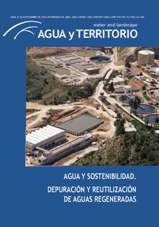La reutilización de aguas depuradas regeneradas a escala mundial: análisis y prospectivas.
DOI:
https://doi.org/10.17561/at.v0i8.3292Resumen
El artículo presenta el estado de la reutilización de aguas residuales a escala mundial. Inicialmente se describen los parámetros que definen el mayor o menor déficit de agua, y se muestran las distintas regiones con déficit hídrico. Se revisan las principales causas que provocan el aumento en todo el mundo de esta problemática. Se incluye una breve reseña sobre sucesos históricos relacionados con el uso de aguas residuales, y se describen los usos posibles de las mismas. Se revisa el estado de la reutilización a escala mundial en los distintos países y regiones, según dos estudios realizados en 2008 y 2013. Finalmente se apuntan las principales razones para un continuo crecimiento de la reutilización de aguas residuales en el futuro, que crece paralelamente a la mejora en su tratamiento, identificando los países donde se espera mayor crecimiento. También se describe como las modernas tecnologías para el tratamiento de aguas residuales, permiten el uso directo o indirecto de las aguas regeneradas utilizándolas como aguas potables, describiendo los ejemplos más significativos.
Descargas
Referencias
Fluet, M. J., Vescovi, L., y Bokoye, A. I. 2009: The United Nations World Water Development Report 3: Water and Climate Change (Citizen Mobilization, a Source of Solutions). Paris, UNESCO.
Intelligence Global Water. 2009: Municipal Water Reuse Markets 2010. Media Analytics Ltd.
Jiménez, B. y Asano, T. 2008: Water Reuse: An International Survey of Current Practice. Issues and Needs. London, IWA Pub. http://dx.doi.org/10.2166/9781780401881
Levine, Audrey D., Leverenz, Harold L. y Asano, T. 2010: “Water Reclamation and Reuse”, in Water and Health [Ed. Willie O.K. Grabow], in Encyclopedia of Life Support Systems (EOLSS). Developed under the Auspices of the UNESCO, Oxford, Eolss Publishers.
Municipal Water Reuse Markets 2010. 2009: Analysis, forecasts and inventory. Oxford, Global Water Intelligence-Media Analytics Ltd.
National Research Council. Committee on the Assessment of Water Reuse as an Approach for Meeting Future Water Supply Needs. 2012: Water Reuse: Potential for Expanding the Nation’s Water Supply Through Reuse of Municipal Wastewater. National Academies Press.
Rajendra, P. y Bhattarai, P. E. 2015: Water Reuse in Texas. Past, Present and Future. Twenty-ninth Surface Water Quality Monitoring: Annual Workshop. Camp Allen-Navasota, Texas.
Raso, J. 2013: Updated report on wastewater reuse in the European Union. Brussels, European Commission.
Sanz, L. A. y Gawlik, B. M. 2014: Water Reuse in Europe-Relevant guidelines, needs for and barriers to innovation. Brussels, Joint Research Centre.
Sato, T., Qadir, M., Yamamoto, S., Endo, T. y Zahoor, A. 2013: “Global, regional, and country level need for data on wastewater generation, treatment, and use”, en Agricultural Water Management, 130, 1-13. http://dx.doi.org/10.1016/j.agwat.2013.08.007
Schertenleib, M. H. y Egli-Brož, H. 2011: Globale Klimatologie: Meteorologie, Wetterinformation und Klimatologie. Compendio Bildungsmedien AG.
Werner, B. y Collins, R. 2012: Towards effi cient use of water resources in Europe. Copenhagen, European Environment Agency.
World Water Development Report, 2015: Water for a Sustainable World.
Paris, UNESCO.
Descargas
Publicado
Número
Sección
Licencia
© Universidad de Jaén
Los originales publicados en las ediciones impresa y electrónica de esta Revista son propiedad de la Universidad de Jaén siendo necesario citar la procedencia en cualquier reproducción parcial o total.
Salvo indicación contraria, todos los contenidos de la edición electrónica se distribuyen bajo una licencia de uso y distribución “Creative Commons Reconocimiento 4.0 España” (CC-by). Puede consultar desde aquí la versión informativa y el texto legal de la licencia. Esta circunstancia ha de hacerse constar expresamente de esta forma cuando sea necesario.














